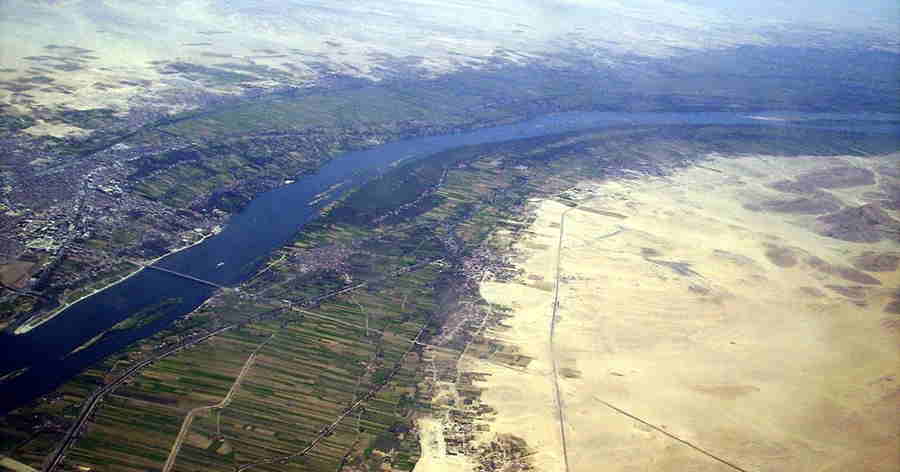

The Nile River, stretching over 6600 miles through northeastern Africa, is one of the world's most iconic and historically significant waterways. Originating from Lake Victoria, it flows through Uganda, South Sudan, Sudan, and finally, Egypt, where it empties into the Mediterranean Sea. Renowned as the longest river on Earth, the Nile has played a pivotal role in the development of ancient civilizations, particularly Egypt, providing fertile soil and sustaining agriculture.

The Congo River, located in Central Africa, ranks as the second-longest river in Africa, after the Nile. It is the only river to cross the equator twice. Rising high in the mountains of the East African Rift, the river flows in a northwesterly direction, before turning south and then west as it enters the Atlantic Ocean. Along its course, the Congo River passes through six countries, namely Angola, Democratic Republic of Congo, Republic of Congo, Central African Republic, Cameroon and the Congo.

The Niger River is a prominent watercourse in West Africa, stretching over 4,180 kilometers in length. The Niger River is formed by two branches, the Togo and the Benue, which merge together at Lokoja in Nigeria. It then continues to flow through Nigeria, Niger, Mali, Guinea, and Burkina Faso before finally emptying into the Atlantic Ocean, at the Gulf of Guinea.

The Zambezi River, one of Africa's most majestic waterways, flows over 3540 km through six countries in southern Africa, including Zambia, Zimbabwe, Angola, Namibia, Botswana, and Mozambique. Originating as a small spring in Zambia, it gains momentum, culminating in the breathtaking Victoria Falls, one of the world's largest and most iconic waterfalls.

The Orange River, a significant watercourse in southern Africa, spans approximately 2432 km. It originates in the Drakensberg Mountains of Lesotho, traverses South Africa and Namibia, and flows into the Atlantic Ocean. This river is a lifeline in an arid region, supplying water for agriculture and serving as a vital source of irrigation. It is named after the Dutch royal House of Orange.

The Ubangi-Uele River is a major river located in the Central African Republic and the Democratic Republic of Congo. It is a tributary of the Congo River and is the longest river in Central Africa, measuring 2,270 km in length. The Ubangi-Uele is a slow-moving, meandering river, with a wide floodplain full of marshes, lagoons and swamps. The Ubangi-Uele River originates in the Central African Republic, where it is known as the Ubangi, and flows north into the Democratic Republic of Congo, where it is known as the Uele. The Ubangi then continues to flow northward, passing through the towns of Kaga-Bandoro, Bambari, and Damara before meeting its largest tributary, the Bomu River, near the town of Zongo. From there, the Ubangi-Uele continues northward,passing through the cities of Isiro, Dungu, and Bunia before eventually joining the Congo River near the town of Bumba.

The Kasai River is an approximately 2,153 km long river located in Central Africa. It is a major tributary of the Congo River and forms part of the greater Congo Basin. The river originates in the highlands of the Democratic Republic of the Congo, where it is known as the Lualaba River. Its main tributaries are the Lomami, the Lulua, and the Sankuru Rivers. The Kasai River begins in the Democratic Republic of the Congo and flows southward to join the Congo River near Ilebo in the Republic of Congo. Along its journey, it passes through some of the densest forests in Africa and serves as a major transportation route for the region.

The Shebelle River is one of the longest rivers in East Africa, stretching for an impressive 1,820 km. It is an important source of water for several countries in the region including Ethiopia, Somalia, and Djibouti. The river originates in the mountains of southeast Ethiopia, where it flows southward, eventually reaching the Somali border. From there, it heads westward, across the Ogaden Desert, before finally reaching the Gulf of Aden in Djibouti. Along its journey, the river passes through several cities, including Jijiga, Dire Dawa, and Mogadishu in Somalia.

The Lualaba River, situated in Central Africa, is a major tributary of the Congo River. Flowing over 1800 km, it primarily runs through the Democratic Republic of the Congo (DRC). It's renowned for its pivotal role in the Congo River's overall hydrology. The Lualaba originates in the Katanga Plateau and winds through lush forests, swamps, and savannas, eventually joining the Congo River.

The Kwango River is a major river in the Democratic Republic of Congo (DRC) stretching over 1,770 km. It rises in the south-central part of the country, in the highlands near Mwene-Ditu, and flows northward, then westward and finally southward, emptying into the Congo River. Along its course it passes through the cities of Kenge, Idiofa, Kikwit, and Kwamouth. The Kwango River is a major tributary of the Congo River, helping to form the large Congo basin.